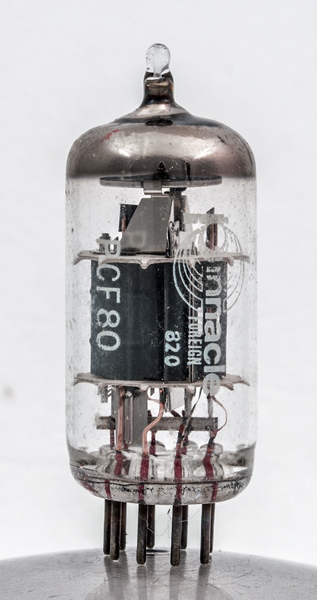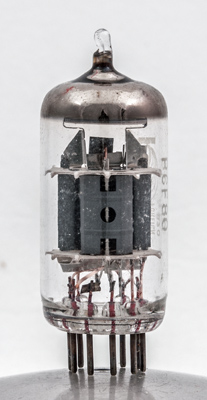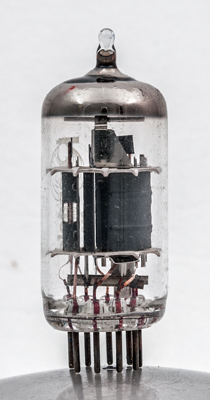|
PCF80Sensibly equivalent¶ to:See also:
|
|
|

|
The PCF80 is from the era of VHF Band III television. Band III television in the UK began in 1955, up to that date the only program was the one BBC channel in Band I (around 50 MHz). The Band III service was the start of commercial television and moved consumer equipment to three times the previous frequency band.The valve is a triode pentode, with separate cathodes, designed to function as a mixer and oscillator in the tuner.The article referenced above gives details of the faults and performance of the PCF80. Mullard also advertise the PCF80 as a video amplifier and cathode follower in a single envelope.See also PCC84 for the corresponding pre-amplifier valve for Band III television tuners from the mid 1950s.
The end wall of the pentode. Within the anode can be seen the suppressor grid and its support.
Left is the triode, with the grid visible through the end of the anode. In the centre is the electrostatic screen. To the right, and at right angles to the triode axis is the pentode section. The shield extends above the top mica and curls round the pentode. The radiating fins on the pentode control grid can be seen on top of thier copper supports.The thin glass tube envelope is 21 mm in diameter and, excluding the B9A base pins, is 49 mm tall.References: Data-sheet & 1040. Type PCF80 was first introduced in 1953. See also 1953 adverts. |
Pin Connections
| 1 | 2 | 3 | 4 | 5 | 6 | 7 | 8 | 9 |  a(t) | g1 | g2 | h | h | a | k,s,g3 | k(t) | g1(t) |
|
|
Absolute Maximum Operating Conditions¶
| Vh | Ah | Va | Vs | Vg | mAa | mAs | ra | gm | 
| 9 | 0.3 | 170 | 170 | -5.5 | 5.2 | 1.5 | 0.87M | 2.1 |
|
Absolute Maximum Operating Conditions¶
| Va | Vg | mAa | 
| 100 | -2 | 14 |
|
Updated January 07, 2016.
|
|